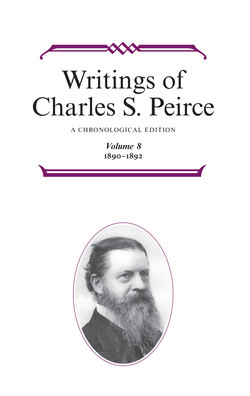Writings of Charles S. Peirce: A Chronological Edition, Volume 8

Реклама. ООО «ЛитРес», ИНН: 7719571260.
Оглавление
Charles S. Peirce. Writings of Charles S. Peirce: A Chronological Edition, Volume 8
Отрывок из книги
Writings of Charles S. Peirce
Volume 8
.....
Early in March 1892, Peirce sent Newcomb a question involving “fundamental points relating to infinity” and said he would like “to see how you would answer it.” It was a problem involving parallel lines and an infinite series of equidistant perpendiculars. On 9 March, Newcomb responded: “Your last letter seems decisive in favor of a proposition which I have often been inclined to maintain, to wit, that all philosophical and logical discussion is useless. If there is any one question which illustrates the correctness of the doctrine of infinities, always maintained by me, it is the very one suggested by the demonstration you and Halsted sent me. I have always held that infinity, considered in itself, could not be treated as a mathematical quantity, and that it is pure nonsense to talk about one infinity being greater or less than another.” This astonishing response, as Carolyn Eisele put it well, reveals Newcomb’s “extreme conservatism,”83 which refused “to entertain a hypothesis which had not yet come completely unscathed through the acid test of experiment…. Peirce was, without doubt, the more daring intellectual of the two.”84
Peirce’s opportunity to write something about Mendeleyev’s Principles came when the editor of the Nation received a letter, signed “C. De K.,” responding to the review of 4 February (written by Peirce’s “rival”) in which it was claimed that Mendeleyev was the discoverer of the Periodic Law. C. De K. acknowledged that Mendeleyev, along with Lothar Meyer, had been recognized by the Royal Society of London “for their discovery of the periodic relations of the atomic weights,” but he claimed that the priority for discovering the Periodic Law belonged to John A. R. Newlands, a fact later recognized by the Royal Society. C. De K.’s letter appeared in the 3 March issue of the Nation followed by an editor’s reply written by Peirce (sel. 48). Peirce pointed out that the Royal Society “did not commit themselves very far” in their acknowledgment of Newlands’s contribution and that “the step taken by him was not a difficult one.” Peirce named Josiah P. Cooke as the “principal precursor” of Mendeleyev for having “first proved that all the elements were arranged in a natural series.” Peirce suggested that “[a]fter the new atomic weights came in” it was inevitable that “every well-informed and ingenious chemist” would begin “speculating upon the relations of the properties and atomic weights of the elements” and that these speculations would naturally be laid out in tables. He gave, as an example of such early speculations, a table based on one he had published anonymously in 1869 (W2, sel. 25)—which he ascribed to an “obscure American chemist”—and noted that “this was all, if not more than all, that Newlands did.” It was Mendeleyev alone who “had the sagacity to discern the true scheme of relationship,” thus accomplishing one of the greatest inductions in the history of science. Peirce concluded his editorial reply by speculating that the atoms of the chemical elements may have “been built up from a few kinds” of subatomic “atomicules that are Boscovichian points,” an idea he would take up in his fourth Monist article, “Man’s Glassy Essence” (sel. 29), which he would begin writing a few weeks later.85
.....